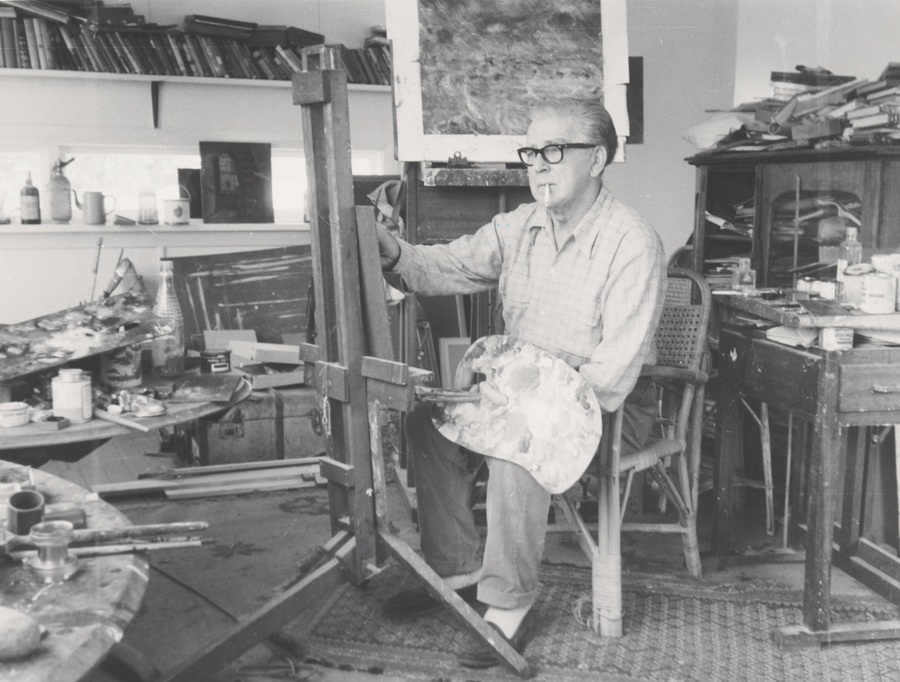About Sir William Dobell
Sir William Dobell (1899-1970) was an Australian painter, best known for his expressive and unique portraits. Although a 3-time winner of the Archibald Prize for portraiture, William’s artistic career was marred with controversy and his first Archibald win was challenged in the Supreme Court. Despite this, William is remembered as one of Australia’s best-known artists and his impact on portraiture is still felt today.
Location
Category
Share and save

Early artistic leanings
William Dobell was born in Newcastle in 1899. Despite originally pursuing a career in architecture, William’s interest in art led him to enrol at the Julian Ashton Art School in Sydney in 1924. In 1929 he won the Society of Artists' 2-year travelling scholarship, enabling him to study in London and travel in Europe.
While William remained private about his sexuality throughout his life, in London he was more open. The influence of this in his artwork became more overt during this period.
Coming home
William remained overseas for 10 years, returning to Australia in 1939 and settling in Sydney’s Kings Cross. Inspired by the lively and colourful life of the area, he produced a ‘gallery of Australian types’, painted in the ‘racy, Dickensian style’ he had developed while in London.
Official artist in the Second World War
During the war, William worked initially with a Civil Construction Corps camouflage unit. His talents were then well-utilised when he served with the Allied Works Council as an official war artist from 1942 to 1944.
William also painted for himself during this time. Some of his wartime paintings include 'The Billy Boy' and 'Cement Worker, Sydney Graving Dock'.
Renown and controversy come hand-in-hand
In 1942, William exhibited with Margaret Preston at the Art Gallery of New South Wales. The following year his growing standing turned to notoriety when he won the Archibald Prize for the first time. His depiction of fellow artist Joshua Smith was condemned by artists Joseph Wolinski and Mary Edwards. Both fiercely conservative, they brought a court case against William and the Archibald trustees, claiming that the work was ‘a distorted and caricatured form’ and therefore not a portrait. In response, William claimed that he was ‘trying to create something, instead of copying something’.
Retreat to Wangi Wangi
The case brought by Wolinski and Edwards was dismissed by the court in 1944, but William was deeply affected, both physically and mentally, by the publicity and negative public opinion. In 1945, he retreated to the family holiday home ‘Allawah’ at Wangi Wangi (Lake Macquarie). William continued to live in Wangi Wangi until his death in 1970.
Career resurgence
In 1949, William won his second Archibald Prize for his portrait of Margaret Olley, as well as the Wynne Prize, awarded for ‘the best landscape painting of Australian scenery in oils or watercolours or the best example of figure sculpture by Australian artists’ for 'Storm approaching Wangi'. Highlights from his later career include his portraits of Mary Gilmore and the cosmetician Helena Rubinstein, both in 1957, which are now recognised as being among his major artistic achievements.
William won his third Archibald Prize in 1960 for a portrait of his surgeon, Dr EG MacMahon. He was also commissioned by Time magazine to develop 4 cover illustrations, the first of which was published in 1960 and featured then Prime Minister Robert Menzies.
In 1964, the Art Gallery of New South Wales held a retrospective exhibition of William’s work. James Gleeson's biography, William Dobell, was published in the same year. Further acknowledgement of William’s artistic achievements followed with an Order of the British Empire (OBE) in 1965 and knighthood in 1966.
Leaving a legacy
William died at home in Wangi Wangi in 1970. The Sir William Dobell Art Foundation was established in 1971 from his bequest, with instructions that‘a Foundation be established for the benefit and promotion of art in NSW’. The Foundation assisted in purchasing artworks for the collection and sponsors an annual drawing prize, now known as the Australian Drawing Biennial.
The Sir William Dobell Memorial Committee was formed in 1971 and continues to be responsible for the maintenance and preservation of William’s home and studio in Wangi Wangi, now known as ‘Dobell House’.
Further reading
'Sir William Dobell', Dobell House, Wangi Wangi, New South Wales.
'William Dobell', Art Gallery of NSW.
Mary Eagle, 'Sir William Dobell (1899–1970)', Australian Dictionary of Biography, National Centre of Biography, Australian National University.
